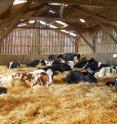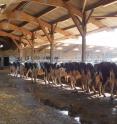Protein in, ammonia out
Related images
(click to enlarge)
Ammonia gas packs quite the smelly punch. In small doses, it's what makes smelling salts so effective. But high levels of ammonia can be a health hazard and a pollutant. Dairy farms are one of the major sources of ammonia emissions. The U.S. Environmental Protection Agency estimated that dairy farms contributed more than 20% of the ammonia emitted from animal husbandry operations in 2015.
Now, a recent study has compiled and analyzed data from 25 previous studies. Researchers honed in on factors that influence how much ammonia dairy barns emit.
The goal was to figure out which factors influence ammonia emissions in dairy barns and to, ultimately, lower the amount of ammonia being released from dairy facilities, says Adeline Bougouin, lead author of the study. That's important because ammonia poses several dangers.
In the confined spaces of many farm buildings, high levels of ammonia can be a threat to animals. Ammonia is also linked to the respiratory problems in humans. In the environment, ammonia can damage terrestrial and aquatic ecosystems.
"Our work is important because it provides key information to farmers and farm advisers about potential ways to lower ammonia emissions," says Bougouin. Bougouin was a researcher at Wageningen University in The Netherlands and is now working at the French National Institute for Agricultural Research.
But reducing the amount of ammonia being emitted from dairy farms is a complex endeavor. Farms, after all, are economic enterprises. A solution needs to fit with the bottom line.
"Farmers need concrete strategies that reduce the environmental impact of their farms but not their economic output," says Bougouin.
So, Bougouin and her colleagues looked at existing research.
These studies had cataloged several factors that influence how much ammonia dairy barns release. They looked at both environmental factors, such as seasons and temperature, as well as the diet and nutrition of the dairy cattle.
"We confirmed that both environmental factors and nutritional aspects significantly influence ammonia emissions from dairy barns," says Bougouin.
Some of the factors influencing ammonia emission--such as seasons--are beyond a farmer's control. Others, however, are not. Take, for instance, the amount of crude protein in the animals' diet. "Crude protein is a measurement of the total amount of nitrogen in feed," says Bougouin. Turns out, nitrogen in the diet is not broken down efficiently by cattle. It is excreted as urea, mostly through urine. When urine and feces mix, the urea is rapidly converted into ammonia, which is then released into the atmosphere.
Bougouin found that reducing the amount of crude protein slightly in a dairy cow's diet reduced the amount of nitrogen in manure and urea in urine. And it did not affect milk yield. Reducing excess nitrogen in the diet could be an effective strategy to reduce ammonia emissions without affecting a farm's bottom line.
Other factors that influence the amount of ammonia being released from dairy barns include the type of flooring system used in it, the amount of dry matter in dairy cattle feed, and milk yield per cow.
The findings come with some caveats. "The emission rates we describe in the study may not represent whole-farm ammonia losses," says Bougouin. Emissions can also occur during manure storage or during composting and field application.
"We will need to study whole-farm ammonia losses," says Bougouin. "Then we can better understand how various systems in farms contribute to total ammonia emissions."
Source: American Society of Agronomy
Other sources
- Protein in, ammonia outfrom Science DailyThu, 30 Jun 2016, 13:21:07 UTC
- Protein in, ammonia out: Cattle diet impacts ammonia emissionsfrom PhysorgWed, 29 Jun 2016, 20:41:08 UTC
- Protein in, Ammonia Outfrom Newswise - ScinewsWed, 29 Jun 2016, 18:51:36 UTC


